Temperature-Controlled Switchable Photonic Nanojet Generated by Truncated Cylindrical Structure
Abstract
1. Introduction
2. Numerical Results and Discussion
2.1. The Model of Truncated Cylinder
2.2. The Simulation of Truncated Cylinder
2.3. Simulation of Truncated Cylinder-Covering VO2 Film
3. Conclusions
Author Contributions
Funding
Institutional Review Board Statement
Informed Consent Statement
Data Availability Statement
Conflicts of Interest
References
- Minin, I.V.; Geints, Y.E.; Zemlyanov, A.A.; Minin, O.V. Specular-reflection photonic nanojet: Physical basis and optical trapping application. Opt. Express 2020, 28, 22690–22704. [Google Scholar] [CrossRef]
- Surdo, S.; Duocastella, M.; Diaspro, A. Nanopatterning with photonic nanojets: Review and perspectives in biomedical research. Micromachines 2021, 12, 256. [Google Scholar] [CrossRef]
- Zhang, C.; Lin, J.; Gu, M. High-quality longitudinally polarized photonic nanojet created by a microdisk. Opt. Lett. 2021, 46, 3127–3130. [Google Scholar] [CrossRef]
- Liu, C.Y. Flexible photonic nanojet formed by cylindrical graded-index lens. Crystals 2019, 9, 198. [Google Scholar] [CrossRef]
- Yue, Y.; Hu, X.; Wang, R.; Qiao, X. Generation of long photonic nanojet by a self-assembled microdevice on optical fiber. Opt. Laser Technol. 2023, 159, 109043. [Google Scholar] [CrossRef]
- Zeng, X.; Su, N.; Zhang, W.; Ye, Z.; Wu, P.; Liu, B. Generation of Photonic Nanojet Using Gold Film Dielectric Microdisk Structure. Materials 2023, 16, 3146. [Google Scholar] [CrossRef]
- Liu, C.Y. Ultra–high transmission of photonic nanojet induced modes in chains of core–shell microcylinders. Phys. Lett. A 2012, 376, 3261–3266. [Google Scholar] [CrossRef]
- Lin, C.B.; Lee, Y.T.; Liu, C.Y. Optimal photonic nanojet beam shaping by mesoscale dielectric dome lens. J. Appl. Phys. 2020, 127, 243110. [Google Scholar] [CrossRef]
- Xing, H.; Zhou, W.; Wu, Y. Side-lobes-controlled photonic nanojet with a horizontal graded-index microcylinder. Opt. Lett. 2018, 43, 4292–4295. [Google Scholar] [CrossRef]
- Ren, Y.X.; Yip, G.G.K.; Zhou, L.M.; Qiu, C.-W.; Shi, J.; Zhou, Y.; Mao, H.; Tsia, K.K.; Wong, K.K.Y. Hysteresis and balance of backaction force on dielectric particles photothermally mediated by photonic nanojet. Nanophotonics 2022, 11, 4231–4244. [Google Scholar] [CrossRef]
- Yue, L.; Yan, B.; Wang, Z. Photonic nanojet of cylindrical metalens assembled by hexagonally arranged nanofibers for breaking the diffraction limit. Opt. Lett. 2016, 41, 1336–1339. [Google Scholar] [CrossRef] [PubMed][Green Version]
- Chen, R.; Lin, J.; Jin, P.; Cada, M.; Ma, Y. Photonic nanojet beam shaping by illumination polarization engineering. Opt. Commun. 2020, 456, 124593. [Google Scholar] [CrossRef]
- Wu, M.; Chen, R.; Soh, J.; Shen, Y.; Jiao, L.; Wu, J.; Chen, X.; Ji, R.; Hong, M. Super-focusing of center-covered engineered microsphere. Sci. Rep. 2016, 6, 31637. [Google Scholar] [CrossRef] [PubMed]
- Ren, Y.X.; Zeng, X.; Zhou, L.M.; Kong, C.; Mao, H.; Qiu, C.-W.; Tsia, K.K.; Wong, K.K.Y. Photonic nanojet mediated backaction of dielectric microparticles. ACS Photonics 2020, 7, 1483–1490. [Google Scholar] [CrossRef]
- Kim, M.S.; Scharf, T.; Mühlig, S.; Rockstuhl, C.; Herzig, H.P. Engineering photonic nanojets. Opt. Express 2011, 19, 10206–10220. [Google Scholar] [CrossRef] [PubMed]
- Mandal, A.; Tiwari, P.; Upputuri, P.K.; Dantham, V.R. Characteristic parameters of photonic nanojets of single dielectric microspheres illuminated by focused broadband radiation. Sci. Rep. 2022, 12, 173. [Google Scholar] [CrossRef]
- Chen, W.Y.; Liu, Y.Y.; Kong, J.A.N.; Li, L.P.; Chen, Y.B.; Cheng, C.H.; Liu, C.Y. Biological cell trapping and manipulation of a photonic nanojet by a specific microcone-shaped optical fiber tip. Opt. Lett. 2023, 48, 1216–1219. [Google Scholar] [CrossRef]
- Liu, J.; Guan, C.; Chen, H.; Liu, B.; Cheng, T.; Yang, J.; Shi, J.; Yuan, L. Dual-core optical fiber tweezers based on all-dielectric metasurface. Opt. Commun. 2023, 531, 129232. [Google Scholar] [CrossRef]
- Littlefield, A.J.; Zhu, J.; Messinger, J.F.; Goddard, L.L. Photonic nanojets. Opt. Photonics News 2021, 32, 34–41. [Google Scholar]
- Gašparić, V.; Ristić, D.; Gebavi, H.; Ivanda, M. Resolution and signal enhancement of Raman mapping by photonic nanojet of a microsphere. Appl. Surf. Sci. 2021, 545, 149036. [Google Scholar] [CrossRef]
- Yousefi, M.; Scharf, T.; Rossi, M. Photonic nanojet generation under converging and diverging beams. JOSA B 2021, 38, 317–326. [Google Scholar] [CrossRef]
- Liu, C.Y.; Hsiao, K.L. Direct imaging of optimal photonic nanojets from core–shell microcylinders. Opt. Lett. 2015, 40, 5303–5306. [Google Scholar] [CrossRef]
- Pierron, R.; Chabrol, G.; Roques, S.; Pfeiffer, P.; Yehouessi, J.-P.; Bouwmans, G.; Lecler, S. Large-mode-area optical fiber for photonic nanojet generation. Opt. Lett. 2019, 44, 2474–2477. [Google Scholar] [CrossRef] [PubMed]
- Guo, J.; Wu, Y.; Gong, Z.; Chen, X.; Cao, F.; Kala, S.; Qiu, Z.; Zhao, X.; Chen, J.; He, D.; et al. Photonic Nanojet-Mediated Optogenetics. Adv. Sci. 2022, 9, 2104140. [Google Scholar] [CrossRef]
- Mandal, A.; Dantham, V.R. Photonic nanojets generated by single microspheres of various sizes illuminated by resonant and non-resonant focused Gaussian beams of different waists. JOSA B 2020, 37, 977–986. [Google Scholar] [CrossRef]
- Zhang, P.; Yan, B.; Gu, G.; Yu, Z.; Chen, X.; Wang, Z.; Yang, H. Localized photonic nanojet based sensing platform for highly efficient signal amplification and quantitative biosensing. Sens. Actuators B Chem. 2022, 357, 131401. [Google Scholar] [CrossRef]
- Hisatake, S.; Miyake, E. Terahertz scanning microscopy with 2λ depth of field based on photonic nanojet generated by a dielectric cuboid probe. Opt. Express 2022, 30, 45303–45311. [Google Scholar] [CrossRef]
- Zhang, Y.; Wu, P.; Zhou, Z.; Chen, X.; Yi, Z.; Zhu, J.; Zhang, T.; Jile, H. Study on temperature adjustable terahertz metamaterial absorber based on vanadium dioxide. IEEE Access 2020, 8, 85154–85161. [Google Scholar] [CrossRef]
- Sullivan, D.M. A simplified PML for use with the FDTD method. IEEE Microw. Guid. Wave Lett. 1996, 6, 97. [Google Scholar] [CrossRef]
- Liu, C.Y.; Yen, T.P.; Minin, O.V.; Minin, I.V. Engineering photonic nanojet by a graded-index micro-cuboid. Phys. E Low Dimens. Syst. Nanostruct. 2018, 98, 105–110. [Google Scholar] [CrossRef]
- Lysenko, S.; Rua, A.J.; Vikhnin, V.; Jimenez, J.; Fernandez, F.; Liu, H. Light-induced ultrafast phase transitions in VO2 thin film. Appl. Surf. Sci. 2006, 252, 5512–5515. [Google Scholar] [CrossRef]
- Nikoo, M.S.; Soleimanzadeh, R.; Krammer, A.; Park, Y.; Son, J.; Schueler, A.; Moll, P.J.; Matioli, E. Electrical control of glass–like dynamics in vanadium dioxide for data storage and processing. Nat. Electron. 2022, 5, 596–603. [Google Scholar] [CrossRef]
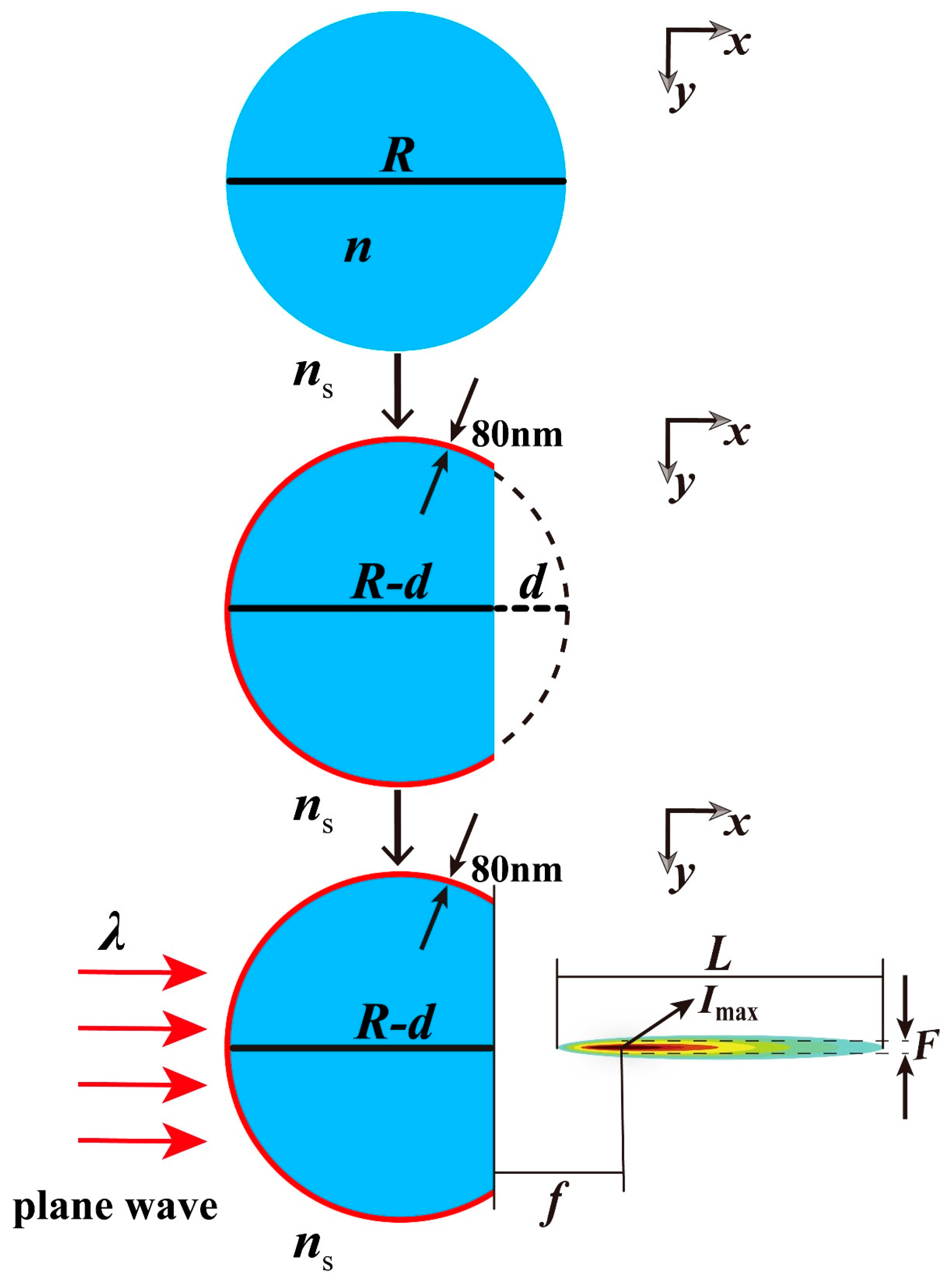

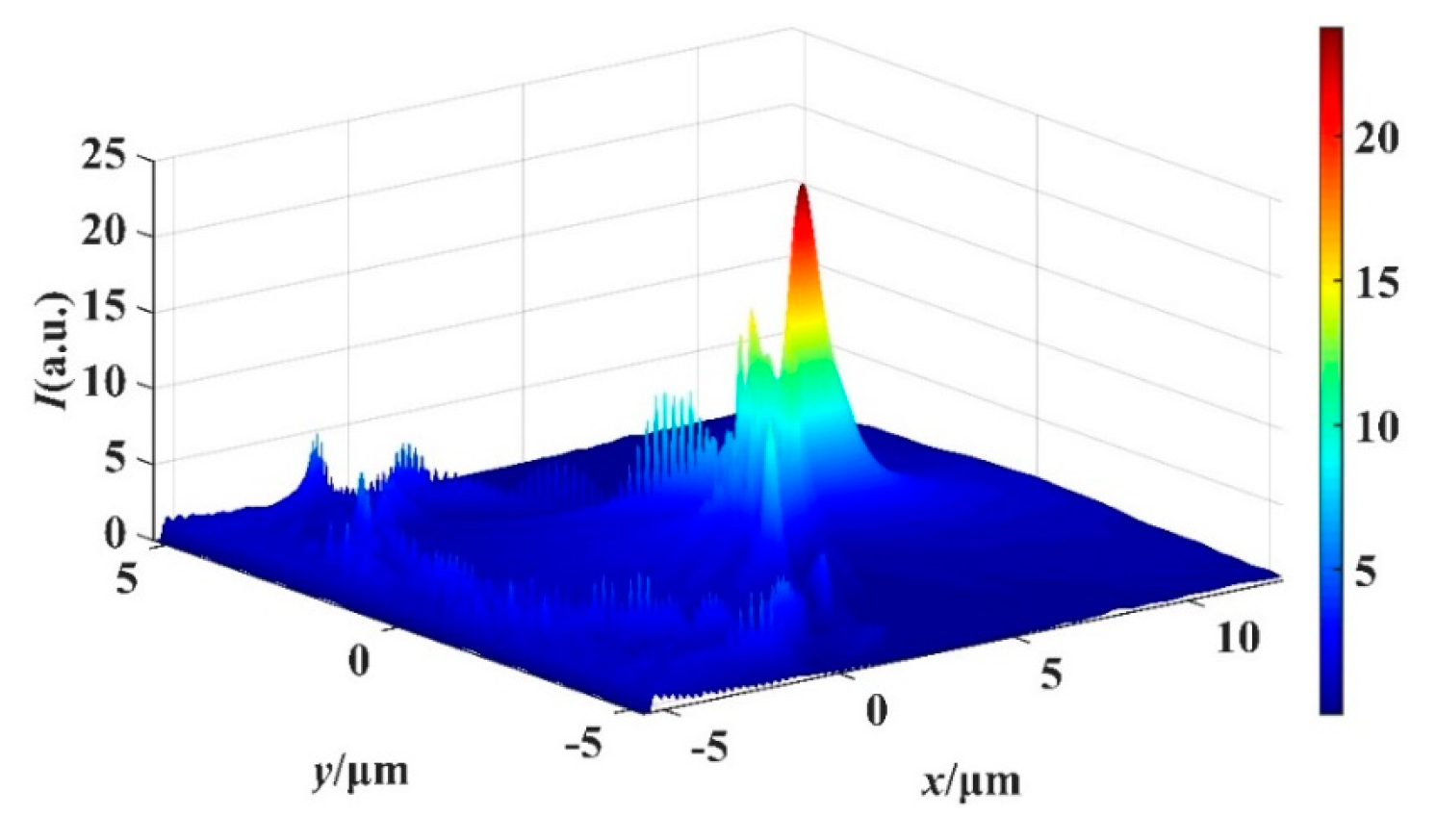
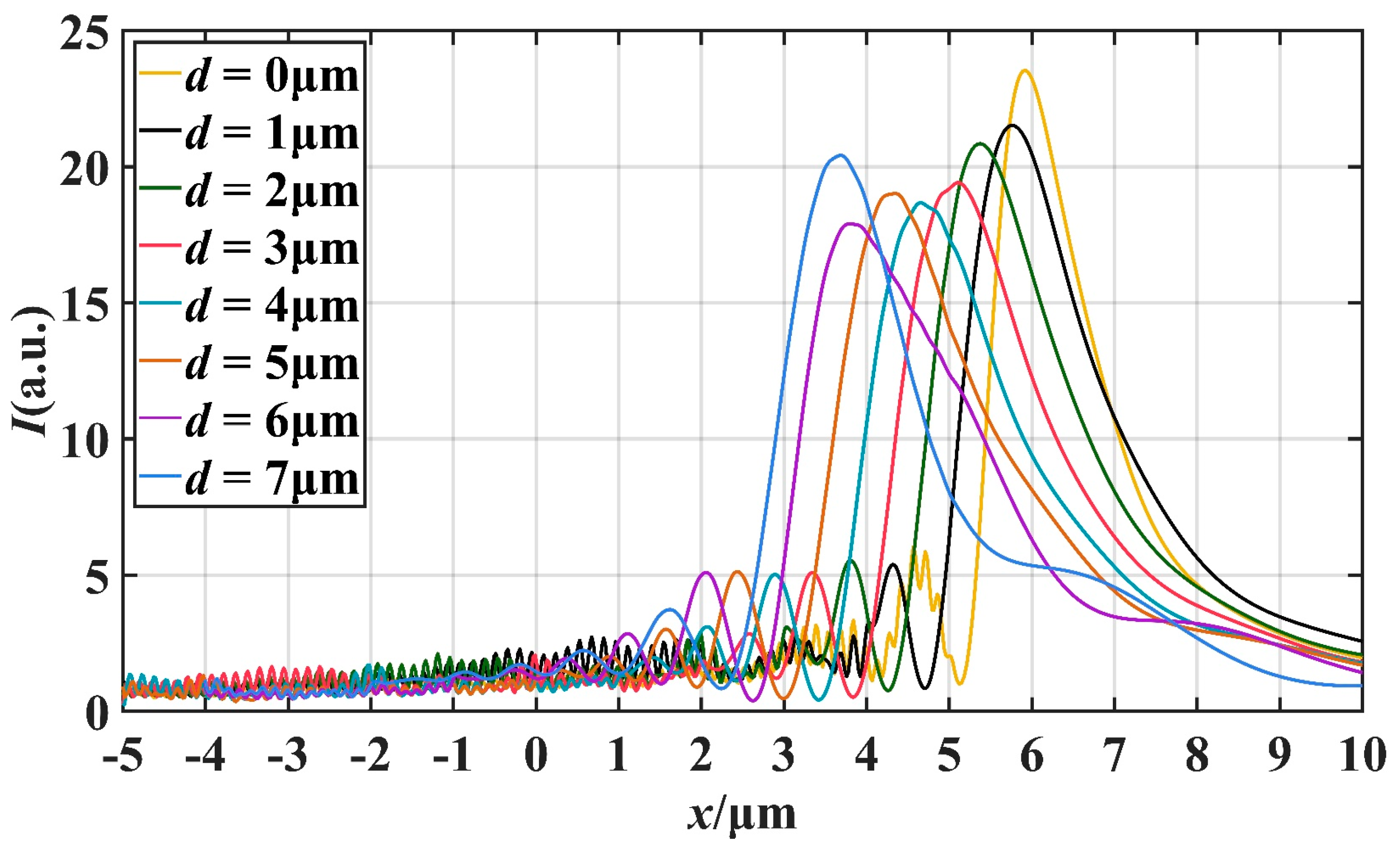
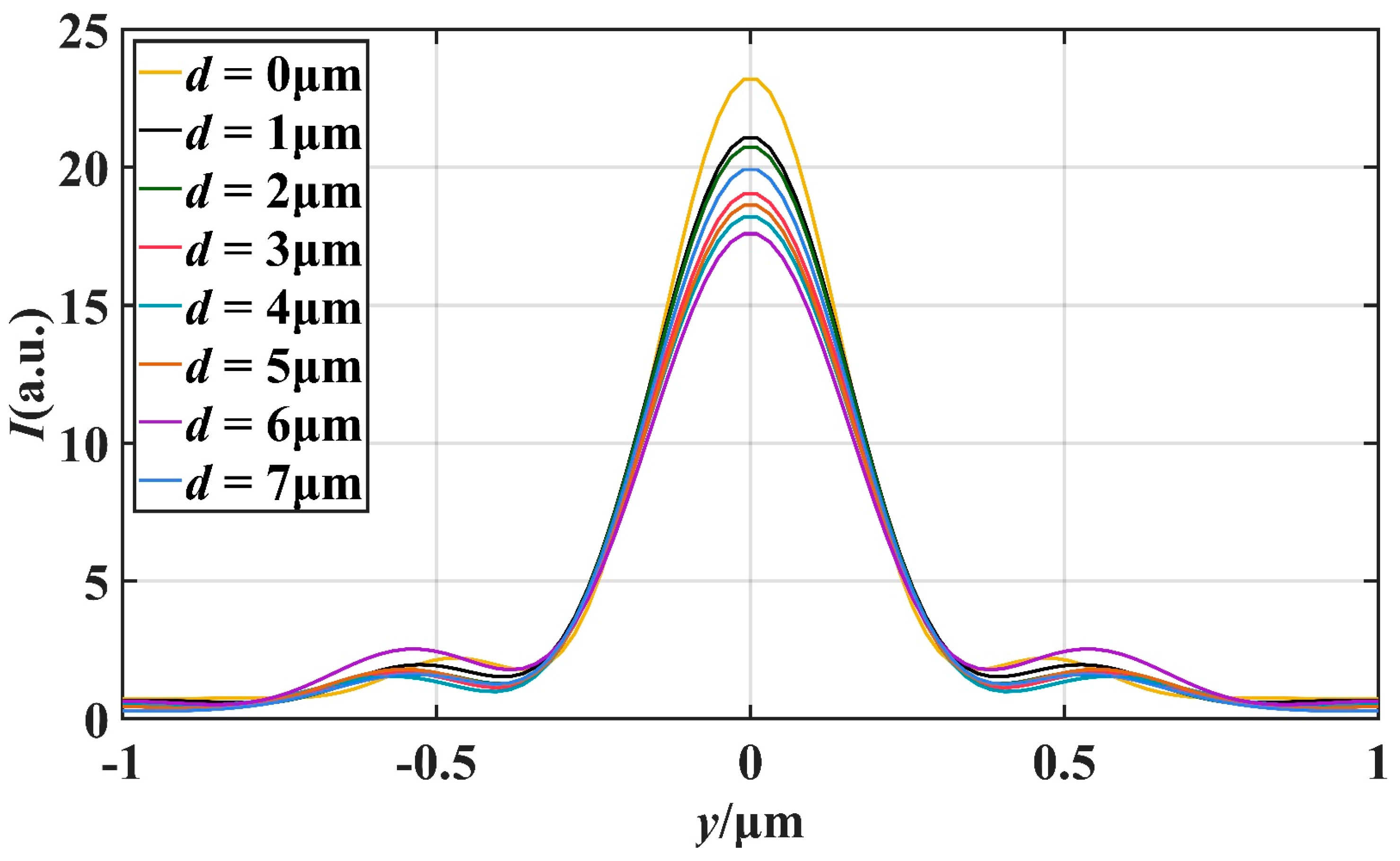


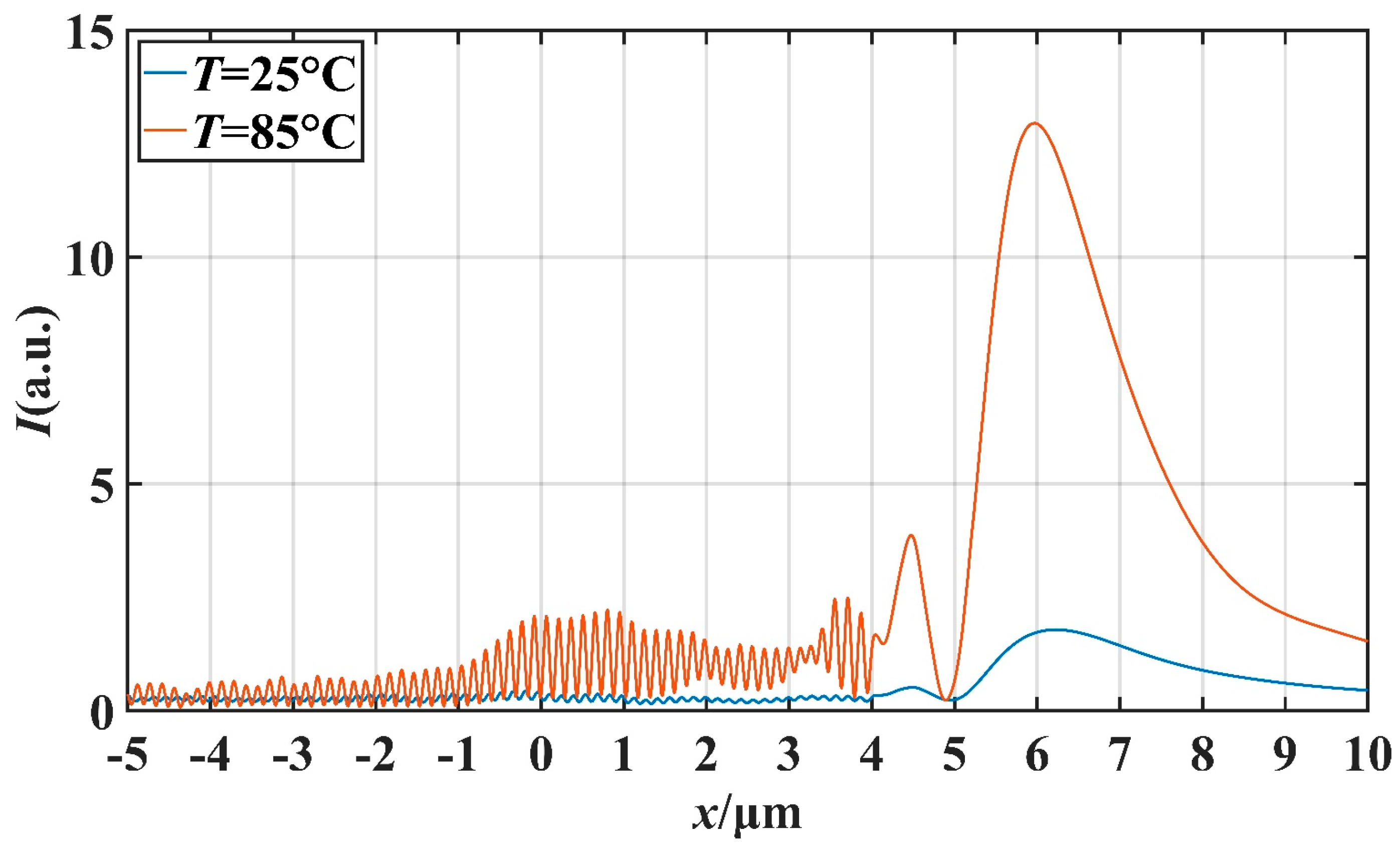
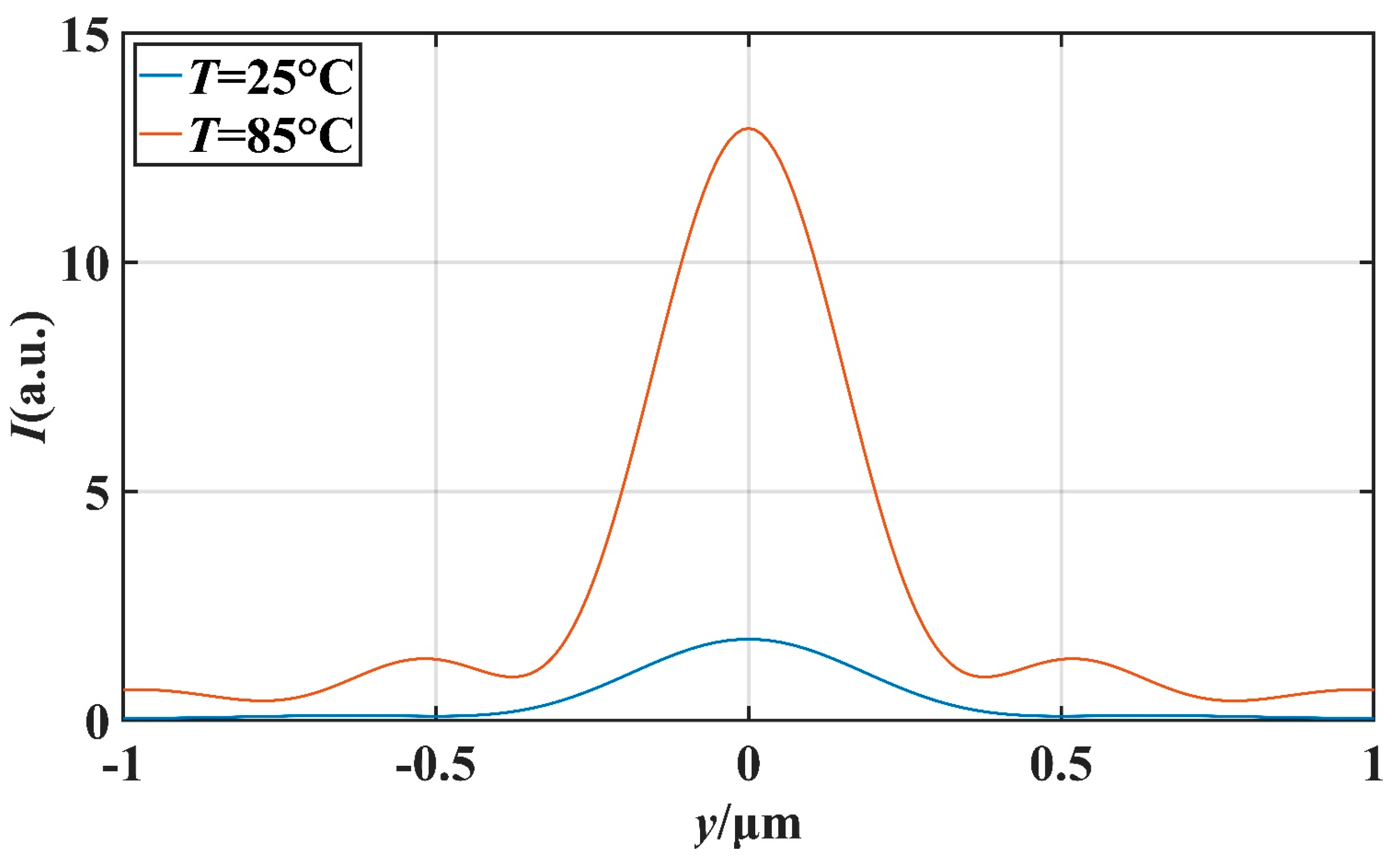
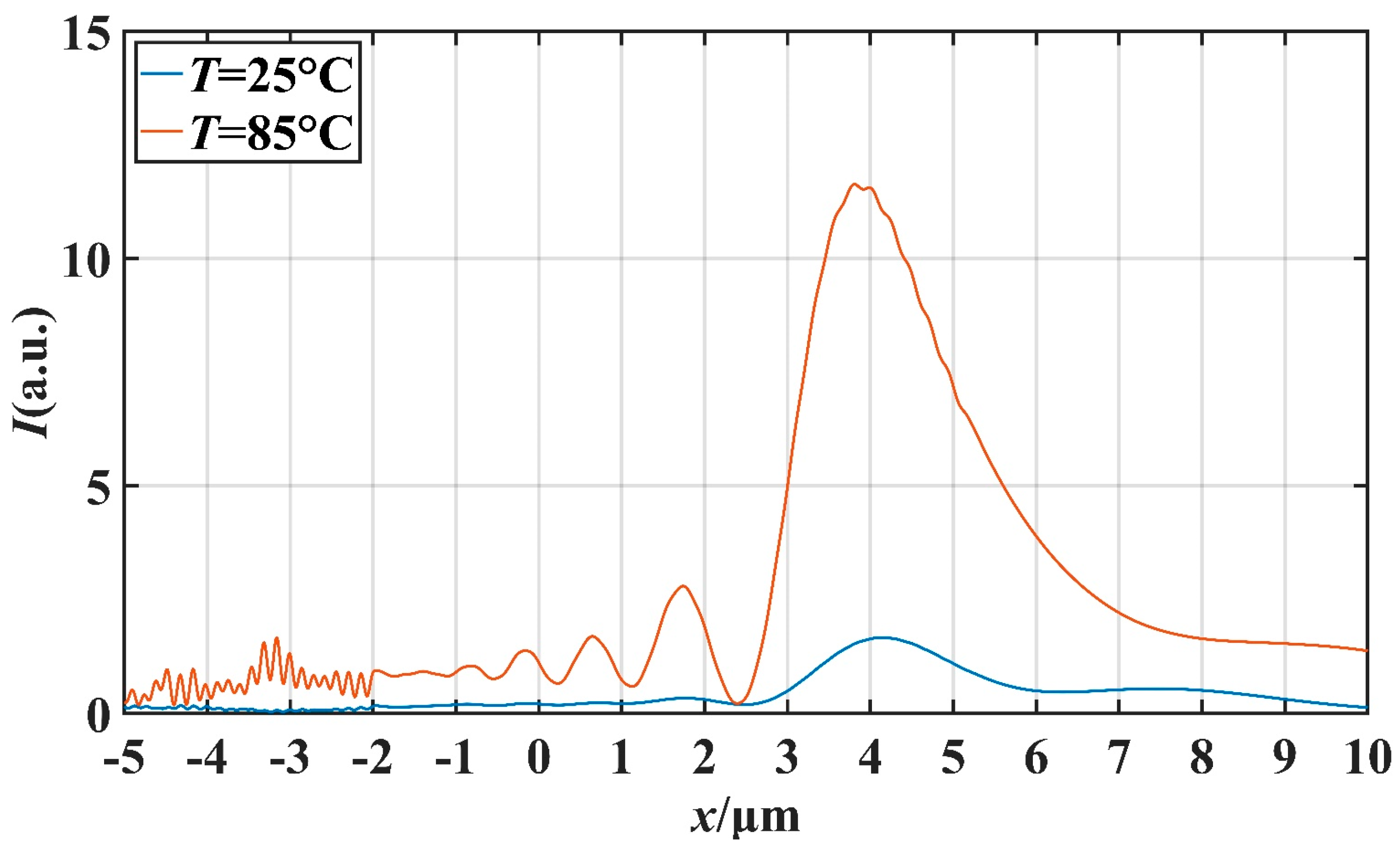
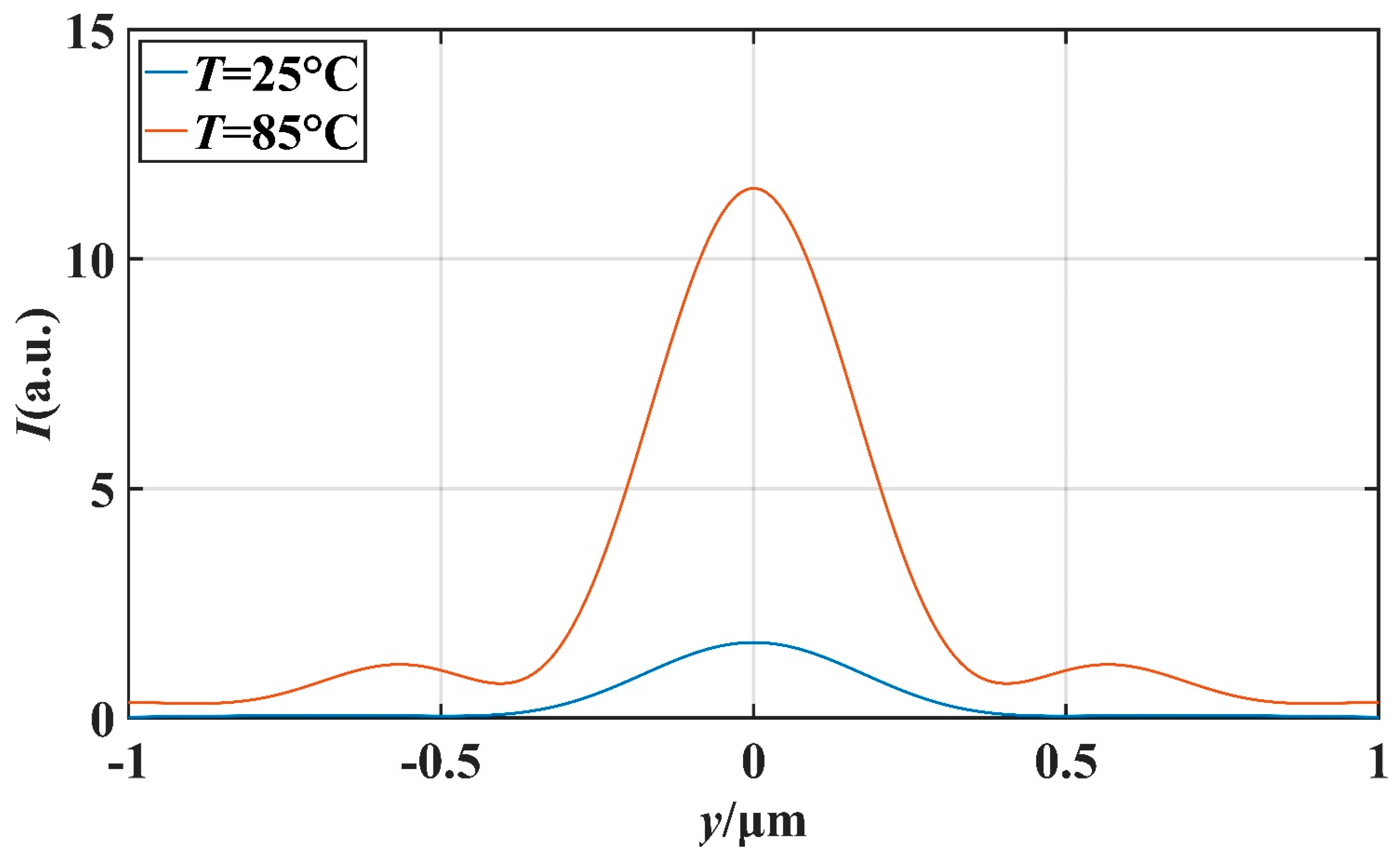
| d (μm) | Imax (a.u.) | F (μm) | L (μm) | Q | f (μm) |
|---|---|---|---|---|---|
| 0 | 23.64 | 0.324 (0.720λ) | 1.29 (2.87λ) | 94.12 | 0.92 (2.07λ) |
| 1.0 | 21.56 | 0.350 (0.778λ) | 1.72 (3.82λ) | 105.95 | 1.76 (3.91λ) |
| 2.0 | 20.89 | 0.352 (0.782λ) | 1.70 (3.78λ) | 100.89 | 2.37 (5.27λ) |
| 3.0 | 19.47 | 0.360 (0.800λ) | 1.71 (3.80λ) | 82.98 | 3.12 (6.93λ) |
| 4.0 | 18.71 | 0.365 (0.811λ) | 1.91 (4.24λ) | 97.91 | 3.65 (8.11λ) |
| 5.0 | 19.03 | 0.358 (0.796λ) | 1.92 (4.27λ) | 102.06 | 4.36 (9.69λ) |
| 6.0 | 17.90 | 0.361 (0.802λ) | 2.14 (4.76λ) | 106.11 | 4.76 (10.58λ) |
| 7.0 | 20.44 | 0.355 (0.789λ) | 2.15 (4.78λ) | 123.79 | 6.70 (14.89λ) |
| d (μm) | Imax (a.u.) | F (μm) | L (μm) | Q | f (μm) |
|---|---|---|---|---|---|
| 1.0 | 1.79 | 0.419 (0.931λ) | 3.50 (7.78λ) | 14.95 | 2.21 (4.91λ) |
| 7.0 | 1.67 | 0.391 (0.869λ) | 2.58 (5.73λ) | 11.02 | 6.10 (13.56λ) |
| d (μm) | Imax (a.u.) | F (μm) | L (μm) | Q | f (μm) |
|---|---|---|---|---|---|
| 1.0 | 12.98 | 0.347 (0.771λ) | 2.40 (5.33λ) | 89.78 | 1.98 (4.40λ) |
| 7.0 | 11.61 | 0.388 (0.862λ) | 2.91 (6.47λ) | 87.01 | 6.80 (15.11λ) |
Disclaimer/Publisher’s Note: The statements, opinions and data contained in all publications are solely those of the individual author(s) and contributor(s) and not of MDPI and/or the editor(s). MDPI and/or the editor(s) disclaim responsibility for any injury to people or property resulting from any ideas, methods, instructions or products referred to in the content. |
© 2023 by the authors. Licensee MDPI, Basel, Switzerland. This article is an open access article distributed under the terms and conditions of the Creative Commons Attribution (CC BY) license (https://creativecommons.org/licenses/by/4.0/).
Share and Cite
Su, N.; Zhang, W.; Zeng, X.; Wu, P.; Cui, L.; Chen, X. Temperature-Controlled Switchable Photonic Nanojet Generated by Truncated Cylindrical Structure. Materials 2023, 16, 7209. https://doi.org/10.3390/ma16227209
Su N, Zhang W, Zeng X, Wu P, Cui L, Chen X. Temperature-Controlled Switchable Photonic Nanojet Generated by Truncated Cylindrical Structure. Materials. 2023; 16(22):7209. https://doi.org/10.3390/ma16227209
Chicago/Turabian StyleSu, Ning, Weiming Zhang, Xintao Zeng, Pinghui Wu, Lina Cui, and Xiaohui Chen. 2023. "Temperature-Controlled Switchable Photonic Nanojet Generated by Truncated Cylindrical Structure" Materials 16, no. 22: 7209. https://doi.org/10.3390/ma16227209
APA StyleSu, N., Zhang, W., Zeng, X., Wu, P., Cui, L., & Chen, X. (2023). Temperature-Controlled Switchable Photonic Nanojet Generated by Truncated Cylindrical Structure. Materials, 16(22), 7209. https://doi.org/10.3390/ma16227209







